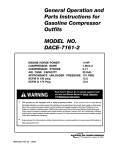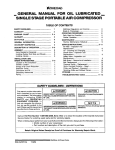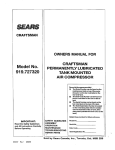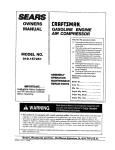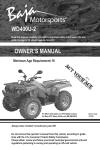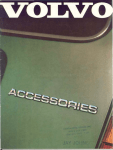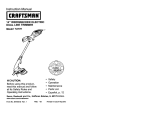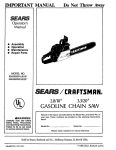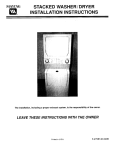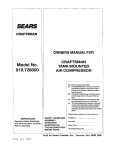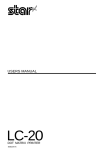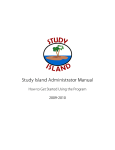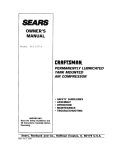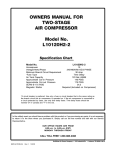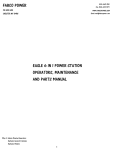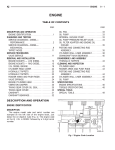Download DeVillbiss Air Power Company SP-100-F Troubleshooting guide
Transcript
General Operation and Parts Instructions for Gasoline Outfits Compressor MODEL NO. DACE-7161-2 ENGINE HORSE POWER COMPRESSOR BORE COMPRESSOR STROKE AIR TANK CAPACITY APPROXIMATE SCFM SCFM e This product UNLOADER 11liP PRESSURE @ 100 psig @ 175 Psig is not equipped with 1.96/4.3 2.17 30 GAL. 175 PSIG 12.5 12,0 a spark arresting muffler. If the product will be used around flammable materials, or on land covered with materials such asagricultural crops, forest, brush,grass, or other similar items, then an approved spark arrester must be installed and is legally required in the state of California. It is a violation of California statutes section 130050 and/or sections 4442 and 4443 of the California Public Resources Code, unless the engine is equipped with a spark arrestor, as defined in section 4442, and maintained in effective working order. Spark arresters are also required on some U. S. Forest service land and may also be legally required under other statutesand ordinances. e Engine exhaust from this product containschemicalsknown, in certain quantities,to causecancer,birth defects or other reproductive harm. J_,V//.B/SS _13 MGP-DAC-7161-2A 7/9/99 A/R _ Indus_lal €_O/ImulqJIIY Dr. • Jacb_n, TN 38301 TABLE OF CONTENTS Page No. SAFETY PRECAUTIONS ................................................................................... 3-5 GENERAL INFORMATION .................................................................................... 6 COMPRESSOR DIAGRAM ................................................................................... 7 DESCRIPTION OF OPERATION ......................................................................... 6 INSTALLATION ................................................................................................ 8-10 Pre-lnstallationInspection................................................................................ 8 Vibration Mounting Kit (StationaryCompressor Outfits).................................... 8 Location of the Compressor Outfit ................................................................ 8-9 Air Line Piping(Stationary Compressor Outfits) ........................................... 9-10 OPERATION ................................................................................................... 11-14 Operator Controls ..................................................................................... 11-12 Daily Startup Procedures .......................................................................... 13-14 Break-In Procedures....................................................................................... 13 MAINTENANCE ............................................................................................. 14-17 Routine Maintenance Schedule ...................................................................... 14 Cleaning the Air Compressor Outfit ................................................................. 15 Checking and Changing Oil ............................................................................ 16 Checking and Changing Air Intake Filter.......................................................... 16 DrainingWater from Air Tank ........................................................................... 16 Checking and Adjusting Belt Tension.............................................................. 17 SERVICE INSTRUCTIONS ............................................................................ 17-19 Replacing Drive Belt ................................................................................. 17-18 Engine Pulleyand Flywheel Alignment ............................................................ 18 Check Valve Inspection and Cleaning ....................................................... 18-19 Servicing Intake and Exhaust Valves .............................................................. 19 TROUBLESHOOTING GUIDE ....................................................................... Air Compressor Diagram & Parts List ........................................................ Compressor Pump Diagram & Parts List................................................... 20-24 26-27 28-29 WARRANTY ......................................................................................................... 30 SERVICE NOTES .................................................................................................. 31 ORDERING REPAIR PARTS ................................................................................ 32 PAGE 2 SAFETY GUIDELINES - DEFINITIONS This manual contains information that is important for you to know and understand. This information relates to protect ing YOUR SAFETY and PREVENTING EQUIPMENT PROBLEMS. To help you recognize this information, we use th_ symbols to the right. Please read the manual and pay attention to these sections. I Jk DANGER IA I DANGER indicates an imminently hazardous situation which, if not avoided, will result in death or serious CAUTION CAUTION indicates a potentially which, if not avoided, I hazardous situation may result in minor or moder- injury. I _WARNING I WARNING indicates a potentially hazardous situation which, if not avoided, could result in death or serious injury. IMPORTANT • I CAUTION I CAUTION used without the safety alert symbol indicates a potentially hazardous situation which, if net avoided, may result in _roDertv damaae. SAFETY INSTRUCTIONS SAVE THESE INSTRUCTIONS , IMPROPER OPERATION OR MAINTENANCE OF THIS PRODUCT COULD RESULT IN SERIOUS INJURY AND PROPERTY DAMAGE. READ AND UNDERSTAND ALL WARNINGS AND OPERATING INSTRUCTIONS BEFORE USING THIS EQUIPMENT, WHAT CAN HAPPEN HAZARD RISK OF EXPLOSION OR FIRE HOW TO PREVENT IT GASOUNE AND GASOLINE VAPORS CAN BY COMING INTO CONTACT WITH HOT COMPONENTS SUCH AS THE MUFFLER, GASES, OR FROM AN ELECTRICAL SPARK. TURN ENGINE OFF AND ALLOW IT TO COOL BEFORE ADDING FUEL TO THE TANK. EQUIP AREA OF OPERATION WITH A FIRE EXTINGUISHER CERTIFIED TO HANDLE GASOLINE OR FUEL FIRES. COMBUSTIBLE MATERIALS WHICH COME INTO CONTACT WITH HOT ENGINE PARTS CAN BECOME IGNITED. ADD FUEL OUTDOORS OR IN A WELL VENTILATED AREA. MAKE SURE THERE ARE NO SOURCES OF IGNITION, SUCH AS CIGARETTES NEAR REFUELING LOCATION. OPERATE COMPRESSOR IN AN OPEN AREA AWAY FROM DRY BRUSH, WEEDS OR OTHER COMBUSTIBLE MATERIALS. STORE FUEL IN A SECURE AWAY FROM COMPRESSOR. UNATTENDED OPERATION OF THIS PRODUCT COULD RESULT IN PERSONAL INJURY RISK OF BURSTING LOCATION ALWAYS REMAIN IN A'FrENDANCE WITH THE PRODUCT WHEN IT IS OPERATING. AIR TANK THE FOLLOWING CONDITIONS COULD LEAD TO A WEAKENING OF THE TANK, AND RESULT IN A VIOLENT TANK EXPLOSION: 1. FAILURE TO PROPERLY DRAIN CONDENSED CAUSING RUST AND THINNING OF THE STEEL TANK. DRAIN TANK DAILY OR AFTER EACH USE. IF TANK DEVELOPS A LEAK, REPLACE IT IMMEDIATELY WITH A NEW TANK OR NEW COMPRESSOR OUTFIT. 2. MODIFICATIONS REPAIRS NEVER DRILL INTO, WELD, OR MAKE _Y MODIFICATIONS TO THE TANK OR ITS ATTACHMENTS. OR A'I-FEMPTED PAGE 3 HAZARD RISK WHAT CAN HAPPEN HOW TO PREVENT IT OF BURSTING AIR TANK (cont'd) 3. UNAUTHORIZED MODIFICATIONS TO THE UNLOADER VALVE. SAFETy VALVE. OR ANy WHICH CONTROL TANK THE TANK IS DESIGNED TO WITHSTAND SPECIFIC OPERATING PRESSURES. NEVER MAKE ADJUSTMENTS OR PART(; SUBSTITUTIONS TO ALTER THE FACTORY SET OPERATING 4. EXCESSIVE DO NOT REMOVE THE STIFFENER BAR CONNECTING THE COMPRESSOR PUMP TO THE ENGINE, EXCEPT TO ADJUST BELT TENSION, THEN SECURELY TIGHTEN THE STIFFNER BAR NUTS. THIS BAR CONTROLS OUTFIT VIBRA- VIBRATION CAN WEAKEN AND CAUSE RUPTURE OR EXPLOSION. WILL OCCUR IF THE COMPRESSOR 18 OR IF THE ENGINE OPERATES ABOVE RECOMMENDED RPM. ATTACHMENTS RISK FROM FLYING OBJECTS I T1ON. & ACCESSORIES EXCEEDING THE PRESSURE RATING OF _R TOOLS. SPRAY GUNS, AIR OPERATED ACCESSORIES, TIRES AND OTHER INFLATABLES T XPLODE OR FLY APART, AND COULD RESULT IN SERIOUS INJURY. FOR ESSENTIAL CONTROL OF AIR PRESSURE, YOU MUST REGULATOR AND PRESSURE GAUGE OF YOUR COMPRESSOR. FOLLOW THE EQUIPMENT MANUFACTURERS RECOMMENDATION AND NEVER EXCEED THE MAXIMUM ALLOWABLE PRESSURE RATING OF A1TACHMENTS. NEVER USE COMPRESSOR TO INFLATE SMALL LOW-PRESSURE OmlJECTS SUCH AS CHILDREN'S TOYS. FOOTBALLS. BASKETBALLS. ETC. THE _ STREAM CAN CAUSE SOFT TISSUE DAMAGE TO EXPOSED SKIN AND CAN PROPEL DIRT, CHIPS, _ AND SMALL OBJECTS AT _ RESULTING IN PROPERTY DAMAGE OR PERSONAL INJURY. ALWAYS WEAR ANSI Z87.1 APPROVED SAFETY GLASSES WITH SIDE SHIELDS WHEN USING THE COMPRESSOR. NEVER POINT ANY NOZZLE OR SPRAYER TOWARD ANY PART OF THE BODY OR AT OTHER PEOPLE OR ANIMALS. ALWAYS TURN THE COMPRESSOR OFF FROM THE AIR HOSE AND TANK BEFORE ATTEMPTING MAINTENANCE, AI"rACHING TOOLS OR ACCESSORIES. RISK TO BREATHING BREATHING ENGINE _ EXHAUST FUMES FROM SERIOUS INJURY OR DEATH. THE COMPRESSED AIR FROM YOUR COMPRESSOR THE AIR STREAM MAY CONTAIN CARBON MONOXIDE, TOXIC VAPORS OR SOLID PARTICLES FROM THE TANK. SUCH AS PAINT, PAINT SOLVENTS, PAINT REMOVER, INSECTICIDES, WEED KILLERS, ETC.. CONTAIN HARMFUL VAPORS AND POISONS. PAGE 4 ALWAYS OPERATE AIR COMPRESSOR IN A CLEAN. WELL VENTILATED AREA. AVOID ENCLOSED AREAS SUCH AS GARAGES, BASEMENTS, STORAGE SHEDS, ETC., WHICH LACK A STEADY EXCHANGE OF AIR. UNIT IN ENCLOSED LOCATIONS OCCUPIED BY HUMANS OR ANIMALS. KEEP CHILDREN, PETS AND OTHERS AWAY FROM AREA OF OPERATION. NEVER INHALE AIR FROM THE COMPRESSOR EITHER DIRECTLY OR FROM A BREATHING DEVICE CONNECTED TO THE COMPRESSOR. WORK IN AN AREA WITH GOOD CROSSREAD AND PROVIDE ON THE LABEL OR SAFETY DATA SHEETS FOR THE MATERIAL YOU ARE SPRAYING. USE A NIOSH/MSHA APPROVED DESIGNED FOR USE WITH YOUR SPECIFIC APPLICATION. HAZARD WHAT CAN HAPPEN RISK FROM MOVING PARTS i RISK OF BURNS HOW TO PREVENT IT THE ENGINE CAN START ACCIDENTALLY IF THE FLYWHEEL IS TURNED BY HAND OR MOVED BY PULLING ON THE STARTER ROPE. ALWAYS SP PLUG AND BLEED PRESSURE FROM THE TANK BEFORE PERFORMING MAINTENANCE. MOVING PARTS SUCH AS THE PULLEY, FLYWHEEL AND BELT CAN CAUSE IF THEY COME INTO CONTACT WITH YOU OR YOUR CLOTHING. NEVER OPERATE THE_ W_H GUARDS OR COVERS WHICH ARE DAMAGED OR REMOVED. _L_ COMPRESSOR WITH DAMAGED OR MISSING PANTS OR AI"rEMPTINO TO REPAIR COMPRESSOR WITH PROTECllVE SHROUDS REMOVED CAN EXPOSE YOU TO MOVING PAR_ AND DAN RESULT IN SERIOUS INJURY. ANY REPAIRS REQUIRED ON THIS PRODUCT SHOULD BE PERFORMED BY AUTHORIZED SERVICE CENTER PERSONNEL. TOUCHING EXPOSED METAL SUCH AS THE COMPRESSOR HEAD OR OUTLET TUBES OR CONTACT WITH HOT ENGINE PARTS SUCH AS THE MUFFLER _J_L_I_,T_U_J_ BURNS. NEVER TOUCH ANY EXPOSED METAL PANTS ON ENGINE OR COMPRESSOR DURING OR IMMEDIATELY AFTER OPERATION. ENGINE AND COMPRESSOR WILL REMAIN HOT FOR SEVERAL MINUTES AFTER OPERATION. THE GASOLINE ENGINE, THE ENGINE MUFFLER, THE COMPRESSOR HEAD AND TUBING BECOME VERY HOT DURING OPERATION. DO NOT REACH AROUND PROTECTIVE SHROUDS OR A'I-rEMPT MAINTENANCE UNTIL UNIT HAS BEEN ALLOWED TO COOL. PAGE 5 GENERAL You have pumhaeed a complete compressoroutfit consistingof an air compressor, ASME approved air tank, gasoline engine, and associated controls and instruments. The compressor outfit you have selected is a two stage stationary outfit. Your new compressor can be used for operating paint sprayers, air tools, grease guns, air brushes, caulking guns, and sand blasters, spraying weed killer and insecticides, etc. An air pressure regulator may be necessary for some of these DESCRIPTION The gasoline engine uses a pulley and drive belt to drive the compressor flywheel. The flywheel turns the compressor crankshaft causing the up and down movement of the pistons in the cylinder; this up and down movement draws and compresses the air. On the down strokeofthe piston,air isdrawn inthrough the air intake. The exhaust valves remain closed. On the up stroke of the piston, both the valves are closed and air is compressed in the cylinder. As pressure builds in the cylinderthe exhaust valveopens and the compressed air is forced out of the cylinder through the check valve and into the air tank. This process continuesuntilthe air pressure reaches maximum tank pressure. Working air pressure becomes availablewhen the compressor has raised the tank pressure above that required at the air discharge valve. The air intake must be kept clear of all obstructions which could interfere with air delivery to the compressor. All gasoline compressor outfits are continuously running outfits controlled bytank pressure. At maximum PAGE 6 INFORMATION applications. Refer to Figure 1 for a photograph of the compressorand to identifythe majorcomponents of the compressor. A regularly scheduled program of preventive maintenance is necessaryto insurethe long lifethat has been designed into your DeVilbiss compressor outfit. This instruction manual, along with regular maintenance will maintain your compressor outfit in good working order.Beforeoperatingor performingany maintenance on your outfit, refer to these publications. OF OPERATION tank pressure the unloader valve exhausts air to atmosphere (blowoff); tank pressure closes the check valve retainingair pressure inside the tank. When tank pressure drops to a pre-determined pressu,=, ;3,= unloader valve closes, and air pressure opens the check valve allowing compressed air into the tank. As maximum tank pressure is reached, if the unloader valve malfunctions and compressed air is not exhaustedat or near its blowoff setting,the air tank safety valve wilt protect the air tank against high pressure by popping at its factory set pressure. The safety valve popping pressure is slightly higher than the unloader valve blowoff pressure. This compressor outfit is equipped with a gas saving throttle controldevice. When maximum tank pressure is reached and the unloader valve opens the throttle control is also activated, The throttle control holdsthe engine at a factory set idling speed until air pressure in the tank drops to reset or minimum tank pressure. At reset pressure when the unloader valve closes the throttle control is reactivated and the engine accelerates to full throttle. Pump Air Intake Gas Engine Oil Dipstick Engine Filter Belt Guard Fuel Tank Two-Stage Pump Engine Air Filter Pump Oil Fill Plug Engine Oil Drain (Not Shown) Throttle Control Pump Oil Sight Glass Oil Drain Plug PressureGauge Drain Valve (Not Shown) Figure I- Typical Gasoline Air Outlet For Discharge Valve Compressor Outfit PAGE 7 INSTALLATION PRE-INSTALLATION INSPECTION NOTE Each air compressor outfit is carefully checked before shipment. With improper handling, damage may result in transit and cause problems in compressor operation; a bent crankshaft, etc. 2. Insertthevibration mountsin the mountingholes. Place a fiat washer under the mounting surface and secure each mount with a Iockwasher and nut. See Figure 3. Immediatelyon equipmentarrival,checkfor both concealed and visibledamages to avoid expenses being incurred to correctsuch problems.This shouldbe done regardlessof any visible signsof damage to the shipping container.Report any damages to carrier and arrange for inspectionof goods immediately. VIBRATION MOUNTING (Stationary Compressor KIT Outfits) LOCKWASHER Figura3-1nstallation Bolting legs to a stiff surface can cause tank rupture resulting in serious injury or damage. Do not permanently mount compressor to any surface without using the vibration mount kit. Portable compressor outfits may be permanently mounted in one location such as a truck bed, if desired. A vibration mount kit is included with the outfit for this purpose. 1. In order to maintain adequate ventilation for compressor cooling and to avoid contact with pick-up truck bed, always mount the outfit at least 8 inches from any vertical wall. Using the holes in the airtank support legs as a guide, mark and drill four 5/16 inch diameter holes in the mounting surface. To prevent excessive vibration which may cause tank rupture or explosion, never remove the engine stiffener bar or increase the engine RPM. Make sure the engine bolts and stiffener bar nuts are tight. Do not operate the outfit if the rubber feet are not attached. PAGE 8 NUT of Vibration Mounting Kit 3. Set the outfiton top of the vibration mounts (the exposed threaded ends) and secure each mount to the air tank legs with lock washer and nut. LOCATION OF THE COMPRESSOR OUTFIT Engine exhaust contains toxic carbon monoxide. Operate the engine in a well ventilated area only. If inhaled, it can cause dizziness, unconsciousness and possibly death. The air compressoroutfitshould be located as close as possibleto the pointwhere the compressed air is to be used. The area selected should be dry, clean, cool, and well ventilated. Make certain that the outfit is mounted level on a solidfoundation so no strain is imposed on the supportfeet or base. Keep the outfit away from areas which have dirt, vapor,and volatile fumes in the atmosphere which may clogand gum the intakefilterand valves causing inefficient operation. Where this not practicala remote air intake is recommended. NOTE Where a remote air intake is used, enlarge the side of the air intake piping by one pipe size for each t0 feet of length. Stationary outfits must be bolted or lagged to the floor to prevent movement. When lagging down, leave a minimum of 1/8 inch between the bolt and support feet. The use of vibration pads at each support foot is req uired to eliminate the possibility of tank rupture. The flywheel side of the outfitshouldbe placed toward the wall and protected with a totally enclosed belt guard. In no case should the flywheel be closer than 12 to 18 inches from the wall or other obstruction that will interfere with the flow of air through the fan blade flywheel. See Table 1 for recommended distances. The area should allow space on all sides for air circulation and for ease of normal maintenance. The compressor outfit must not be operated in any confined area where heat from the outfit can not readily escape. Damage to the outfit may result. Pipe thread sealant must be used on all threads, and all joints are to be made up tight, since small leaks in the pipingsystem are the largestsingle cause of high operating costs. All piping should be sloped to an accessible drain point and all outlets should be taken from the top of the main distributionair line so that moisture cannot enter the outlet. The main distribution air line should not be smaller than the compressorair dischargevalve outlet.A smaller line will restrictthe flow of air. For long air lines, refer to Table 2, Pipe Sizes for Compressed Air Lines, for recommended pipe sizes. It is recommended that a flexible couplingbe installedbetween the air dischargevalve outlet and main air distribution lineto allowfor vibration. To remove entrained dirt, oil and water, installseparator in the main distribution line, a sufficient distance from the compressor.This will allowthe air to cool to room temperature before passing through the separator. Additional separators or filter may be used depending on the application. NOTE The compressor crankcase and head are designed with fins which allow for proper cooling. Clean or blow offthe fins and any other parts of the compressor outfit that collect dust or dirt. A clean compressor runs cooler and provides longer service. Do not place rags, containers, or other matedal in or against the belt guard which will obstruct ventilation openings necessary for For underground installation, bury air lines below the frost line and avoid pockets where condensation can gather and freeze. Apply pressure before underground lines are covered to make sure all pipe joints are free from leaks. proper compressor operating temperatures. AIR LINE PIPING (STATIONARY COMPRESSOR OUTFITS) Table 2 Pipe Sizes for Compressed Air Lines AIR cfm The use of plastic pipe, soldered joint, or failure to insure system capability of flex joints and flexible hose can result in mechanical failure, property damage, and serious injury. Plastic or PVC pipe is not designed for usewith compressed air. Regardless of its indicated pressure rating, plastic pipe can burst from air pressure. Use only metal pipe for air distribution lines. A typical compressedair distribution system as shown in Figu re 4, page 10 should be of sufficientpipe size to keep the pressure drop between the supply and point of use to a minimum. All pipes and fittings used must be certified safe for the pressures involved. LENGTH OF PIPE LINES IN FEET 25 50 75 100 150 1-5 1/2 1/2 1/2 1/2 1/2 10 1/2 1/2 1/2 1/2 1/2 15 1/2 3/4 3/4 3/4 3/4 20 3/4 3/4 3/4 3/4 3/4 25 3/4 3/4 3/4 3/4 1 30 3/4 3/4 3/4 1 1 35 3/4 3/4 1 1 1 40 3/4 1 1 1 50 1 1 1 1 1 60-70 1 1 1 1 1-1A 80-100 1-IA 1-I/_ I-I,_I-1/_I-Ih 200 250 300 1/2 1/2 142 1/2 1/2 142 3/4 3/4 3/4 3/4 3/4 3/4 1 1 1 1 1 1 1 1 1 1 1 1 1 1 1 1-1/ 1-1A 1-_A 1-Y., 1-V21-I/2 Pipe sizes are in inches PAGE 9 FEEDER LINES SLOPEWITH AIR FLOW AIR FLOW \ AIR FLOW _r--_ MAIN DISTRIBUTION AIR LINES SLOPE PIPE IN DIRECTION OF AIR FLOW. WATER CONDENSATE FLOWS ALONG So'PrOM OF PIPE TO DRAIN LEGS, PREVENTING IT FROM ENTERING FEEDER LINES. REGULATOR AIR USAGE LEGS /N LUBRICATOR OF TRAP DRAIN TRAPS FILTER MOISTURE SEPARATOR AND TRAP FLEXIBLE COUPLING AIR DISCHARGE VALVE COCK VALVE VIBRATION Figure 4. Typical Compressed PAGE 10 Air Distribution PADS System OPERATION Operator Controls The unloader valve for the operation of the gasoline compressor outfit is located between the compressor pump and gasoline engine. The air discharge valve can be located on the end of the air tank. The safety valve and pressure gauge are attached to the tank below the unloader. See page 7. Unloader Valve Pressure loads beyond the design limits may cause tank rupture or explosion. Do not attempt to adjust, remove, or defeat the unloader valve, or change and modify any pressure control device. If replacement is necessary, the same rated valve must be used. The unloader valve, Figure 6, iscontrolledbytank pressure. Compressors with unloaders run continuously and maintain air pressure within set limits. At maximumtank pressurethe unloadervalve opens and the compressed air is exhausted to atmosphere. This preventsthecompressorfrom continuallybuildingmore pressure if air is not needed. When the tank pressure drops to a predetermined minimum pressure, the unloadervalveclosesand the compressoragainbuilds up the tank pressure. Pressure continuesto builduntil maximum tank pressure is achieved. The cycle then repeats itself. The unloader isused because frequent start-upsand stops are impractical with a gasoline engine. The unloadervalve is preset at thefactory. Never attempt to make adjustments to the unloader valve. The toggle leveron thefront of the unloader valve should be pulled out or in the horizontalposition when starting up the compressor. This prevents the compressor from starting under load. Once the engine has reached full throttle, the lever should be pushed to the side, returning it to its original position to allow the compressor pump to build pressure in the air tank. Toggle Lever Figure 6. Unloader Valve PAGE 11 The unloaderthen reactivates the throttle control and accelerates the engine to fullthrottle. Over-pressurization of the air tank may cause tank rupture or explosion. The air tank is protected from overpressurization by a safety valve. Do not eliminate, make adjustments or substitutions to this device. Occasionally pull the ring on the safety valve to make sure it operates freely. If it doesn't, the safety valve must be replaced. Innercooler safety valves used on two stage outfits must be similarly checked. The safety valve, Figure 7, is set at the factory to be pressure approximately 15 pounds higher than the rated pressure of the outfit. Ifthe unloader valve malfunctions and does not exhaust compressed air automatically at maximum tank pressure the safety valve willprotectthe air tank againstexcessive air pressure by poppingoff at its preset pressure. Two stagecompressorswith unloadercontrolswillhave a safety valve on the intercooler, set 50 to 55 pounds. The purpose of this safety valve is to prevent the full tank pressure building up in the large, low pressure cylinderor intercooler. THRO'I-rLE ADDITIONAL CONTROLS REGULATORS AND Since the air tank pressure is usually greater than that which is needed, a separate regulator is usually employed to controlthe air pressure ahead of any individualair drivendevice. The gasoline engine and air compressor pumps on all compressor outfits are shipped without oil Do not attempt to operate for any reason without first adding oil to the engine and compressor pump crankcase. Serious damage can result from even very limited operation unless filled with oil and broken in correctly. Make sure to closely follow the initial startup procedures. NOTE The compressor outfit should be placed on a level surface in a dry, clean, well ventilated, area. Do not place any material on or against the belt guard. This blocks ventilator openings necessary for proper compressor cooling. CONTROL A gas saving throttle control has been incorporated on somecompressor outfits.Duringnormaloperation, as maximum tank pressure is obtained, the unloader exhausts compressed air and activates the throttle control of the engine. The throttle control holds the engine at a factory set idling speed until air pressure in the tank drops to reset or minimum tank pressure. 1. Remove the oilfill plugson the gasoline engine and air compressorpump and slowly add oil until the unitsare full. Refer to the "Gasoline Engine Owners Manual"for recommended oils and fill capacitiesfor the engine. The compressor pump holds approximately 60 fluid oz.. TWO STAGE COMPRESSOR UNITS Viscosity Chart Figure 7. Safety Valve Recommended Oil (API SG/CD Heavy Duty] Room or Ambient Temperature SAE20 SAE30 Below 20°F Above 32°F Crankcase capacity equals approximately ounces, 60 fluid 2. The air compressor outfitis readyforuse. PAGE 12 3. Periodicallycheck the compressoroutfitduring the first few days of operation to make sure the compressor outfit is runningsmoothly and all controlsare operating properly. NOTE After the compressor has been in operation for 2 to 3 hours, tighten the compressor head bolts. Torque two stage compressor head bolts to 35 foot-pounds using a crisscross pattern when tightening. BREAK-IN PROCEDURES 4. Check the engine fuel tank level.Add fuel if necessary. Before starting the compressor outfit, check the following: . Move the control lever orchoke lever tothe CHOKE position. 7, 8. Turn the engine lever or key switch to the ON position. NOTE If the engine is warm or the air temperature is high, move the control lever or choke lever away from the CHOKE position as soon as the engine starts. Perform steps 1-8 of the Daily StartupProcedures. Open the air dischargevalve. DALLY STARTUP PROCEDURES . Performthe followingchecks beforestartingthe compressoroutfit. 1. Ensurethat nothing is blocking the belt guard air openings. 2. Pullthe dng on the safety valve to make sure the valve moves freely and smoothly. Close the air dischargevalve. 6. Set the toggle lever of the unloadervalve in the vertical positionto relieve compressor head pressure. Start the compressor outfit by pulling the starter handle or by depressing the starter button.Return the toggle lever on the unloader valve to the horizontal positionand allow outfitrunfor 10 minutes without buildingany pressure. Check that the unloader exhausts air at maximum tank pressure. 3. Check the engine and compressoroil levels. Add oil if necessary. If these break-in procedures are not followed, premature pump failure may result and void your warranty. Gasoline is extremely flammable and explosive. Refuel in a well ventilated area with engine stopped. Allow engine to cool before refueling. 10.Check the following: a. Do not smoke or allow flames or sparks in the area where the engine is refueled or where gasoline is stored. Do not overfill the tank and make sure the filler cap is securely closed after refueling. Be careful not to spill fuel when refueling. Fuel vapor or spilled fuel may ignite. If any fuel is spilled, make sure the area is dry before starting the engine. b. Make sure all controlsare operating correctly.Refer to the "Operator Controls" section of this manual. A separate gasoline engine instructionmanual is provideddetailingengineoperation. Check all air lines, fittings and pipes for leaks. Even minor leaks can cause the compressorto overwork resultingin prematurebreakdown or unsatisfactory performance. PAGE 13 c. Check for excessive vibration and noise. Correct any defects found. d. Turn the engine lever or key switchto the OFF position. 2, Check for oil leaks. Correct any leaks found. Close the air dischargevalve. . 4. SHUT DOWN PROCEDURES To stop the engine in an emergency, turn the engine ON/OFF lever or key switch to the OFF position.Under normal conditions,use the following procedures. Remove air tool or accessory. 5. Open outlet valve or regulator to allow air to slowly bleed from the tank. Close the outlet valve or regulator when the tank pressure is approximately20 psig. 6. Drainwater from tank. 1. Allow the tank pressure to buildto maximum and the engine to throttle downto idle speed. MAINTENANCE To ensure efficientoperation and longer life of the air compressor outfit a routine maintenance schedule shouldbe prepared and followed. The followingroutine maintenance schedule is geared to an outfitin a normalworkingenvironment operating on a daily basis. If necessary, the schedule should be modifiedto suitthe conditionsfound with your compressoroutfit. The modificationswill depend upon the hours of operation and the working environment. Compressor outfitsin an extremelydirtyand/orhostileenvironment will require a greater frequency of all maintenance checks. The maintenance label mounted on the air tank also liststhe required maintenance checks. NOTE Drain and refill the compressor pump crankcase after the first 100 hours of operation. Add approximately 60 oz.. to pump. Drain and refill the gasoline engine crankcase after the first 20 hours of operation. See "Gasoline Engine Owners Manual" for engine crankcase capacity. 2. Drain water from the air tank and any moisture separators or trensformers. 3. Check for any unusual noiseand/or vibration. Foradditionalmaintenanceinstructions,recommended oil and fuel on the gasoline engine, refer to "Gasoline Engine Owners Manual". 4. Check the conditionof the air cleaner on the gasoline engine. Clean and/or replace as necessary. 5, ROUTINE MAINTENANCE SCHEDULE DAILY 1. Check the gasoline engine and air compressor pump oil levels; add if necessary. PAGE 14 Manually check the safety valve to make sure it is operating properly. . Check the gasoline engine's fuel level. Add fuel ifnecessary. 7. Inspect for oil leaks and repair any leaks found. CLEANING OUTFIT WEEKLY 1. Clean and inspect the compressor air intake filter; replace if necessary. 2. Inspect condition of drive belt; replace if necessary. 3. Clean outside parts of the compressoras well as the engine in order to maintain efficientcooling. The external components of the compressor outfit shouldbe cleaned at least once a week. The air compressor crankcase and head are designed with fins whichallow for propercooling. Clean or blowoff fins and any other parts of the outfit that collect dirt or dust. A clean compressor runs cooler and provides longer service. CHECKING MONTHLY THE AIR COMPRESSOR AND CHANGING OIL 1. Check the alignment of the engine pulley to the flywheel if necessary, align to within 1/16 inch. Overfilling with oil will cause premature air compressor failure. Do not overfill. 2. Inspectfor and correctany oil leaks. 3. Check drive belt tansion adjust if necessary. 1. Check oil level in compressor crankcase before each use. 4. inspect air lines and fittingsfor leaks; correct as necessary. For two stage compressorsthe oil level should be to the middle of the oil sight glass. NOTE The compressor pump oil must be changed after the first 100 hours of operation. EVERY 50 HOURS OF OPERATION 1. Clean the gasolineengine air cleaner. EVERY 100 HOURS OF OPERATION Changing Oil: 1, Drain and refillthe gasolineengine crenkcase with clean oil. 1. Remove the oilfill and drain plugs.Collect the oil in a suitable container. 2, Clean and set gap or replace spark plug. 2. Replace the oil drain plug and refillthe crankcase with recommended oil. Refertopage 14of this manual for recommended compressoroil. 3. Clean fuel sediment cup. NOTE It is important to maintain the proper oil level. A low oil level reduces proper cylinder wall lubrication and increases ring wear. EVERY 500 HOURS OF OPERATION 1. Drain and refill compressorcrankcasewith clean oil. 3, 4. EVERY 2000 HOURS OF OPERATION, OR IF A PROBLEM IS SUSPECTED Replace the oil fill plug. Startthe engine and run the compressoroutfit for several minutes. Shut the compressordown and check the oil level. If necessary add more oil. 1. Check condition of compressor pump intake and exhaustvalves. Replace if damaged or wornout. PAGE 15 CHECKING AND CHANGING AIR INTAKE FILTER Open the drain valve. Continue operating outfituntil all moistureis removedfrom the tank. Closethe drain valvetightly. NOTE Keep the air filter clean at all times. Do not operate compressor outfit when the filters are removed. The conditionof the air intakefiltershouldbe checked once a week. A dirty air intake filter will not allow the compressortooperate at full capacityandwill increase oilusage. When the air filter becomes dirty, oily,or coveredwith paint overspray it must be replaced. To check and/or replace the air intake filter, remove the screw securing the filter assembly to the air compressor pump. Remove the filter. Inspect condition of filter; replace if necessary. NOTE Felt and foam intake filters can be washed in non-explosive solvent. Allow to dry and reinstall. DO NOT OIL INTAKE FILTERS. DRAINING WATER FROM AIR TANK Water will condense in the air tank. If not drained, the water will corrode and weaken the air tank. A weakened tank may explode or rupture causing personal injury. Drain the tank as instructed below. Water should be drained from the air tank daily. If humidity is high the tank shouldbe drained at regular intervals during the day. Operate the compressor outfit to allow 15 to 20 psi air pressure in the tank. PAGE 16 NOTE If the draincock is clogged, release the air pressure in the tank. Remove the drain valve and clean or replace. Apply sealant to the threads before reinstalling the drain valve. CHECKING TENSION AND ADJUSTING BELT Serious injury or damage may occur if parts of the body or loose items get caught in moving parts. Never operate the compressor outfit with the belt guard removed. The belt guard should only be removed after the spark plug wire has been disconnected. The drive belt shouldbe kept in propertension as a loose belt willslip and wear faster. An over tightened belt will place an excessive load on the engine and compressor pump bearings causing premature failure. The belt tension should be checked as follows: 1. Disconnect the spark plug wire and drein all air pressure from the air tank. 2. Remove the belt guard. 3. Loosen all engine mounting hardware and slide the engine either toward or away from the compressor until correct belt tension is achieved. Hold the belt tension untilthe engine mounting hardware can betightened. 4, DRIVE BELT DOWNWARD FORCE 5. Ensure that the belts are centered on the engine pulley and compressorflywheel. NOTE Once the engine has been moved from its factory set location the engine pulley must align to within 1/16 inch to the compressor flywheel. . COMPRESSOR FLYWHEEL Figure 8. Checking Belt Tension Torqueengine mounting boltsto 20 +3 foot pounds. 7. Reinstallthe belt guard. 8. Connect the spark plug wire. On compressors equipped with standard V-belts, each belt should deflect 1/4" at the midway point between the engine pulley and flywheel when a downwardforce of 4 pounds,or equivalentfinger pressure, is applied at the midway point. Refer to Figure8. SERVICE INSTRUCTIONS Moving parts, unexpected engine start-up and compressed air can cause serious injury. Always disconnect the spark plug wire and relieve pressure from the air tank before performing any of these service procedures. Never operate the air compressor with the belt guard removed. REPLACING DRIVE BELT The gasolineengine is mounted to the tank assembly saddle. By looseningengine mountinghardware, the engine can be moved to allow for easy removal of the belt. Replace the drive belt as follows: 1. Disconnect the spark plug wire and drain all air pressure from the tank. 2. Remove the belt guard. 3. Loosenthe engine mounting hardware and slide the engine toward the compressor. 4. Remove the belt and replacewith a new one. On compressor outfits with matched Vbelts, both belts must be replaced at the same time. NOTE The belts should be centered on the flywheel and engine pulley. Once the engine has been moved from its factory set location, the engine pulley mustalign to within 1/16 inch of the flywheel. PAGE 17 REPLACING DRIVE BELT(cont'd) 6. Reinstall the drive belt. Make sure the belt is centered on the engine pulley and flywheel. 5. 7. Slide the engine back into its originalposition and adjust the belt tension, Figure 8. Slide the engine back intoits originalposition and adjust the belt tension, Figure 8. Forcompressors equipped with standard V-belts, the propertension for each belt is approximately 1/4 inch belt deflectionmeasured midway between the engine pulley and flywheel when a 4 pound downward force, or equivalent finger pressure,is applied at that point. Forcompressorsequipped with poly-V-belts, the proper tension is approximately 1/4 inch belt deflection measured midway between the engine pulleyand flywheelwhen a 3 pound downward force, or equivalentfinger pressure, is applied at that point. 6. Hold the belt tension until the engine mounting hardware can be tightened. 7. Torque engine mounting bolts to 20 +3 footpounds. 8. Reinstall the belt guard. For compressorsequipped with standard V-belts the proper tension for each belt is approximately 1/4 inchbelt deflection measured midway between the engine pulleyand flywheel when a 4 pound downwardforce, or equivalentfinger pressure,is applied at that point. 9. Connect the spark plug wire. 8. Hold the belt tension untilthe engine mounting hardware can be tightened. 9. Torque the engine mounting boltsto 20 +3 footpounds. ENGINE PULLEY AND ALIGNMENT FLYWHEEL The engine pulley and flywheel must be alignedto prevent excessivewear of the drivebelt and to keep the belt from coming out of the pulley and flywheel grooves.Align the belts as follows: Serious injury or damage may occur if parts of the body or loose items get caught in moving parts. Never operate the compressor outfit with belt guard removed. Remove belt guard only after the spark plug had been disconnected. 1. Disconnect the spark plug wire and drain all pressure from the air tank. 2. Remove the belt guard. 3. Loosen all engine mounting hardware and slide the engine toward the compressor. Remove the drive belt. 4. Loosen the engine pulley set screw and move the pulley toward or away from the engine until the pulley aligns with the flywheelwithin 1/116 inch. 5. Torque the engine pulley set screw to 75 +5 inch-pounds. 10. Reinstallthe belt guard. 11. Connect the spark plug wire. CHECK VALVE INSPECTION AND CLEANING Remove and inspectthe check valve at least once a year and more often ifthe compressoris heavily used. Moisture and other contaminates in the hot compressed air will cause an accumulationof carbon-likeresidue on the workingparts. Ifthe valve has heavy carbon build-up, itshouldbe replaced. Use the followingprocedure to inspect, clean, or replacethe checkvalve: 1. Disconnect the spark plug wire and release all air pressure from the air tank. 2. Loosen the top and bottom tube nuts and remove the outlettube. 3. Unscrew the check valve (counterclockwise) from the air tank using a socket wrench. 4. PAGE 18 Check that the valve and disc moves freely inside the check valve and that the spring holdsthe disc in the upper closed position. The check valve may be cleaned with a solvent. 5. Apply pipe sealant to the check valve threads. 6. Reinstall thecheckvalve.DONOTOVERTIGHTEN. Many solvents are highly flammable and a health hazard if inhaled. Always observe the solvent manufacturers safety instructions and warning. SERVICING INTAKE ANDEXHAUST VALVES Theintakeandexhaust valvesas wellasthevalve platesandcylinderheadwill,overaperiodoftime accumulate residue of carbon-like materialon their e. surfaces. The material will decrease the efficiency of the compressor.These componentsshouldbe inspected,whenever a problem is suspected, and cleaned or replaced with new parts. Use the following procedure to inspectthe parts. f. Clean carbon deposits in head cavitiesand valves plates with lacquer thinner or other suitable solvent. Remove the intake and exhaust valve assemblies from the valve plate. Clean and inspect the valves, and valve retainers. Replace any defective componentsas necessary. g. Reassemble the intake and exhaust valves. During service or repair activities always disconnect the spark plug wire before attempting repair maintenance on compressor outfit. Make sure the pressure is released from the air tank. NOTE Do not use gasket cement on any gasket surface as this may clog the compressor valve cavities and flow areas. 1. Disconnect the spark plug wire and drain all air pressure from the air tank. h. 2. Service two stage compressor valves as follows: a. Remove the screws securingthe intercoolerto the cylinder head and remove the intercooler. Install the cylinder head. Use a new head gasket. Snug the mountingscrews tight then torque to 35 foot-pounds usinga cdss cross pattern when torquing. b. Disconnect the outlet linefrom the aftercooler. c. d. Remove the screws securingthe aftercooler to the cylinder head and remove the aftercooler. Removethe hardware securingthe cylinderhead and remove the cylinderhead and valve plate. Reinstallthe valve plate, Use a new valve plate gasket. 4. j. Install a new after cooler gasket. Secure the aftercoolerwith the mountingscrews removed. k. Connect the outlet line to the aftercooler. I. Installnew intercoolergasketsand secure the intercoolerwith the mounting screwsremoved. Connect the spark plug wire. PAGE 19 TROUBLESHOOTING GUIDE Performing service checks or repairs may expose moving parts, or compressed air sources. Personal injuries may occur. Prior to attempting any service check or repairs, remove the spark plug wire and bleed off all air pressure. Never operate the outfit with the belt guard removed. Repairs should be preformed by an Authorized Service Center personnel only. TROUBLESHOOTING PROBLEM Gasoline Engine will not run. (Consult the "Gasoline Engine Owners Manual" for Manufacturer's Service Centers for warranty, repairs and service parts.) CHART CAUSE CORRECTION The gasoline tank is empty. Fill the tank with gas. The choke is not set properly. Reset the choke. Remember, a warm engine requiresless chokingthan a cold engine. Improper fuel mixture. Adjust the fuel mixture. The unloadervalve togglelever is in a horizontalposition. Place unloadingvalve toggle lever in a vertical position. If any fuel is spilled, make sure the area is dry before testing the engine. Fuel vapor or spilled fuel may may ignite. PAGE 20 No spark from the spark plug. Remove the spark plug,clean and adjustgap or replace. Spark plug disconnected. Connect spark plug. TROUBLESHOOTING PROBLEM CHART (Continued) CORRECTION CAUSE Clogged fuel line. Clean. Water in fuel. Be sure outfit is adequately protected from the elements so as to preventwater seeping into system. Faulty choke control, Adjust. See engine manufacturer's instructions includedwith engine. Impreper fuel mixture. Use onlyfuel recommendedby engine manufacturer. See manufacturer'sinstructions. Loose ignition system connections. Check all connectionsto insure tightness. Air leaks in carburetor or manifold connections. Check to be sure all connections are tight, Restricted air intake Clean filteror properlysize pipe to the remote intake. Air leaks in system. Check for source of leak and correct. Undersized unitfor air requirement. Replace with larger unitor purchase a second outfit. Worn or carbonizedvalves. Replace. Flywheel wobbles. Set screw or bolt not tight enough. Tighten. Air leaks. Tube fittingsloose. Tighten fittings with audibleleak and check fittingsunder pressure with soapy water solution. Leak at welds Replace air tank. RoughOperation of Gasoline Engine. (Consult the "Gasoline Engine Owners Manual"for Manufacturer'sService Centerfor warranty, repairs and service parts.) Insufficientair and too much compressor "ON" time. Do not drill Into, weld or otherwise modify air tank or tank will be weakened. Tank must be replaced. If safety valve or unloader valve replacement is necessary, a part with the same rating must be used. PAGE 21 TROUBLESHOOTING PROBLEM Air leaks (cont) Low Discharge Pressure Knocking PAGE 22 CHART (Continued) CAUSE CORRECTION Air leak in safety valve, Operate safety valve manually by pullingon ring. If valve stillleaks, it should be replaced. Defective checkvalve. (Unloader vaive) A defective check valve results in a constant air leak, back through the unloadervalvewhen there is pressure in the air tank and the compressoris notrunning.Turnthe engineoff; move the unloadervalve toggle leverto the verticalposition.Ifair leaksout of the tank throughthe unloadervalve,clean or replacethe checkvalve. (DO NOT OVERTIGHTEN). Prolonged excessive use of air. Decrease amount of air usage, Restrictedcheck valve. Remove and clean, or replace. Restricted air intake filter. Clean or replace air intake filter. Air leaks. Tighten fittings. Hole in hose or air piping. Check and replace if required. Faulty pump. Repair or replace. Loose pulley. Tighten pulley set screw. Low oil level (compressorpump and/or gasolineengine). Check oil level and maintain at prescribedlevel. Restricted check valve. Remove and clean or replace. Wrong oil used. Followoil recommendationslisted in the "Gasoline Engine Owners Manual". Compressor and/orengine bolts loose. Check all bolts and tighten as required. Excessive carbon deposits in head. Remove the head and valve plate. Clean top of piston and bottom of valve plate. Reassemble usingnew gasket and torque screwsto 35 foot-pounds. TROUBLESHOOTING PROBLEM Knocking(cont'd) Excessive Oil Consumption CHART CAUSE CORRECTION Flywheel loose. Make sureflywheelistightbytightening screw. Torquescrewto 20 +5 -0 foot-pounds. Loose belt. Tighten belt. Restricted air intake. Replace. Compressor overworked. Reduce air consumption or add additional air compressorto take up load. Poor qualityor automotive multiviscosityoil used. CompressorOver heating (Continued) Drain pump and replacewith new oil. Excessive engine or compressor shaft end play. Checkpulleyand/orflywheel for lateral movements. Contact engine manufacturer for repair,or DeVilbiss if a compressor problem exists. Compressor Reduceair consumption oradd additionalair compressorto take up load. overworked. Check valve restricted. Clean. Dirty compressor. Clean. High ambient temperature. Use remote air intake. Worn or carbonizedvalves. Replace. Compressor too close to wall. Relocate. Air leaks in system. Check for sourceor leaksand correct. Under sized unit for air requirement. Replace with a larger unit, Unloader notoperating. Replace. Remote air intake pipe to small or restricted. Replace remote air intake pipping. Insufficient "OFF" time. Compressor is runningalmost continuously. Compressor should not exceed 50% run time, which is maximum 30 min/hr. Check for source of leaks and correct, or replace with larger compressor, PAGE 23 TROUBLESHOOTING PROBLEM Compressor Overheating (Cent) Excessive Belt Wear CHART (Continued) CAUSE CORRECTION Restricted air intake. Remove and clean or replace air filter. Improperlevel and/orgrade of oil used. Check for proper oillevels and recommended oilusage. Damaged valves(intake and/or exhaust). Repair or replace as necessary. Loose belt. Adjust belt tension. Pulley misalignment. Align pulley to within 1/16 inch of the flywheel. Loose pulley. Check for worn key or pulley bore. Also check for bent engine shaft. Replace or repair as necessary. Tighten pulley set screw or bolt. Reduced Air Delivery Water in Crankcase; oil appears milky in color. Excessive Water in Air Receiver Tank. PAGE 24 Compressor valvesleaking, sticking or carboned up. Replace. Worn rings. Replace. Head gasket leaking. Tighten or replace gasket. Restricted air intake. Clean or replace. Loose drivebelt. Tighten but don'tovertighten. Unit not reachingproperoperatingtemperature because the compressorrunsfrequently and is oversizedfor the air requirement. Consult with factory or dealer. Humid operating conditions. Relocate compressoroutfit. Change oilfrequently. Avoid cylinderrustingand ringwear. Condensation in the air receiver. This is a normal resultof compressing air and not due to faulty equipment. This conditioncan be corrected by drainingthe air receiverdaily. COMPRESSOR/PUMP DIAGRAM AND PARTS LIST PAGE 25 Air Compressor Diagram Detail A T_QUE TO 1 _2 F_÷I.B. 31 21 22 23 24 25 26 27 38 34 5 33 12 18 PAGE 26 Parts List KEY NO. 1 *2 3 4 5 6 7 8 11 12 13 14 18 19 21 22 23 24 25 26 27 28 29 3O 31 32 33 34 35 36 38 pART NUMBER SSF-3121 -ZN SSP-7824 AC-0606-1 SSP-6461 SSP-1144 ABP-4592 SSF-3159 CAC-1011 CAC-1334-1 SSN-51 91895680 CAC- 1335 DAC-306 CAC-1343-1 ABP-9134350 SSF-3161 GA-359 SSP-6820 TIA-4200 SSP-454 AC-0509 SSF-551 -ZN SSP-535 AC-0510 CAC-1341 SST-106 C-PU-2886 BT-301 CAC-1346-1 CAC-1337 Not Shown SSF-8131 SSF-953-ZN SS-2707 Engine bolt (4 used) 11 HP Gas Engine Nut]Sleeve 5/8" (2 used) Outlet Tube Elbow Bushing Two-Stage Compressor Pump Pump bolt (4 used) Elastomer Bushing (5 used) Belt Guard Inside Washer (5 used) Screw (6 used) Belt Guard Outside Strap, Pump Strap Washer Screw Gauge Tee Safety Valve Nipple Unloader Valve Screw Elbow (2 used) 1/8" NPT Throttle Control Assembly Bushing (includes 3 screws) Key Pulley Belt (2 used) Stiffener Plate Engine Strap Beltguard nut (4 used) Beltguard screw (4 used) Drain Valve *See Engine Manual for Engine Information. PAGE 27 Compressor Pump Diagram V 2 6 8 10 11 PAGE 28 Parts List KEY NO. PARTS 1 2 3 4 5 ABP-8226501 ABP-5961405 ABP-5940055 ABP-5950057 ABP-5281100 Hardware Kit Head Valve Plate Kit Gasket Kit Filter 6 7 8 9 10 11 12 13 • 14 15 16 • 17 ABP-5981000 ABP-9024011 ABP-9022003 ABP-9013013 ABP-9004009 ABP-9110022 ABP-5000101 ABP-5962020 ABP-8226502 ABP-8227093 ABP-8227092 ABP-8226503 Filter Assy. (Includes #5) Oil Filter Plug Sight Glass Split Bearings Flywheel Washer Flywheel Screw Flywheel Intercooler HP Running Gear Kit HP Ring Kit LP Ring Kit LP Running Gear Kit NOT SHOWN ABP-9049020 Intercooler NUMBER DESCRIPTION Safety Valve e lncludes rings, piston pin, snap rings, rods, oil dipper and split bearings. PAGE 29 ONE YEAR LIMITED FROM WARRANTY DATE OF PURCHASE All merchandise manufactured by DeVllbiss Air Power Company/ExCell Manufacturing is warranted to be free of defects in workmanship and material which occur during the first year from the date of purchase by the original purchaser (initial user). Products covered under this warranty include: air compressors, *air tools, accessories, service parts, pressure washers, and generators used in consumer applications (i.e., personal residential household usage only). Air compressors, *air tools, accessories, service parts, pressure washers, and generators used in commercial applications (income producing) are covered by a gO day warranty. DeVilbiss Air Power/ExCell Manufacturing will repair or replace, at DeVilbiss/ExCell's option, products or components which have failed within the warranty period. Repair or replacement, and service calls on 60 and 80 gallon air compressors, will be handled by Authorized Warranty Service Centers and will be scheduled and serviced according to the normal work flow and business hours at the service center location, and depending on the availability of replacement parts. All decisions of DeVllbiss Air Power Company/ExCell Manufacturing with regard to this policy shall be final This warranty gives you specific legal rights, and you may also have other rights which vary from state to state. RESPONSIBILITY OF ORIGINAL PURCHASER (Initial User): Retain original cash register sales receipt as proof of purchase for warranty work. Q Use reasonable care in the operation and maintenance of the product as described in the Owners Manual(s). [31 Deliver or ship the product to the nearest DeVilbiss Air Power/ExCell Manufacturing Authorized Warranty Service Center. Freight costs, if any, must be paid by the purchaser. Q Air compressors with 60 and 80 gallon tanks only will be inspected at the site of installation. Contact the nearest Authorized Warranty Service Center, that provides on-site service calls, for service call arrangement. Q If the purchaser does not receive satisfactoryresults from the Authorized Warranty Service Center, the purchaser should contact DeVilbiss Air Power Company/ExCell Manufacturing. THIS WARRANTY Q [3 Q [3 _1 Q [3 DOES NOT COVER: Merchandise sold as reconditioned, floor models and/or display models. Any damaged or incomplete equipment sold "as is". Merchandise used as "rental" equipment. Merchandise that has become inoperative because of ordinary wear, misuse, treeze damage, use of improper chemicals, negligence, accident, improper and/or unauthorized repair or alterations including failure to operate the product in accordance with the instructions provided in the Owners Manual (s) supplied with the product. *Air Tools: O-Rings and driver blades are considered ordinary wear parts, therefore, they are warranted for a period of 45 days from the date of purchase. An air compressor that pumps air more than 50% during a one hour pehod is considered misuse because the air compressor is undersized for the required air demand. Maximum compressor pumping time per hour is 30 minutes. Merchandise s_d by DeVi_bissAir P_wer_ExCe_lManufacturing which has been manufactureq by and identi_ed as the product of another company. The product manufacturer's warranty will apply. Repair and transportation costs of merchandise determined not to be defective. Cost associated with assembly, required oil, adjustments or other installation and sfart-up cost. ANY INCIDENTAL, INDIRECT OR CONSEQUENTIAL LOSS, DAMAGE, OR EXPENSE THATMAY RESULT FROM ANY DEFECT, FAILURE OR MALFUNCTION OF THE PRODUCT. Some states do notallowthe exclusion or limitation of incidentalor consequential damages, so the above limitationor exclusion may not apply to you. IMPLIED WARRANTIES, INCLUDING THOSE OF MERCHANTABILITYAND FITNESS FORA PARTICULAR PURPOSE, ARE LIMITED TO ONE YEAR FROM THE DATE OF ORIGINAL PURCHASE. Some statesdo not allow limitationson how long an implied warranty lasts, so the above limitations may not apply to you. Ddq/.EBS A/R m Form: 8P*100-F PAGE 30 - 10/28/97 mmMmy FA,V_ f -_gO-8884_t Service Notes PAGE 31 GENERAL OPERATION AND PARTS FOR GASOLINE COMPRESSOR OUTFITS MODEL NO. DACE-7161-2 Call our Toll Free Number 1-800-888-2468, Ext 2, then 1, to obtain the location of the nearest Authorized Service Center for ordering repair parts and for warranty repairs. When ordering repair parts from your local Authorized Service Center, always give the following information: • • Model number of your product Part number and description of the item you wish to purchase WARRANTY Attach This product is covered by the DeVilbiss one year limited warranty. The warranty can be found in the General Manual oris available upon request. Sales Receipt Here. Retain Original Sales Receipt as Proof of Purchase for Warranty Repair Work. DeVllblss Company Air Power • 213 Indusb-ial Or, • Jackson, TN 38301-9615
































